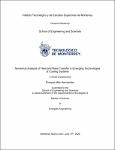| dc.contributor.advisor | Rivera Solorio, Carlos Iván | |
| dc.contributor.author | Mitz Hernández, Enrique | |
| dc.creator | MITZ HERNANDEZ, ENRIQUE; 881783 | |
| dc.date.accessioned | 2021-09-25T00:39:59Z | |
| dc.date.available | 2021-09-25T00:39:59Z | |
| dc.date.created | 2020-06-15 | |
| dc.date.issued | 2020-06-15 | |
| dc.identifier.citation | Mitz Hernández, E. (2020). Numerical analysis of heat and mass transfer in emerging technologies of cooling systems (Tesis de Maestría). Instituto Tecnológico y de Estudios Superiores de Monterrey. Recuperado de: https://hdl.handle.net/11285/639376 | es_MX |
| dc.identifier.uri | https://hdl.handle.net/11285/639376 | |
| dc.description | http://orcid.org/0000-0002-7594-2612 | es_MX |
| dc.description.abstract | We numerically analyze two distinct technologies for air cooling systems: (1) Dew-Point Evaporative Cooling (DPEC) Systems, and (2) Nanofluids in Helical Coils Heat Exchangers (HCHE). For the first technology, we developed a 1D model with thermophysical properties dependent on the temperature, humidity ratio and atmospheric pressure. The model was evaluated under different conditions in a parametric analysis. Then, a regression maintaining the same atmospheric pressure and channel length was found for the DPEC model. The regression shows a good fit with modeled data, having a RMSE of 1.4 and R2adj
of 93%. Also, the model was evaluated in 4 climates (Very arid, arid, warm, and mild). On the other hand, the Nanofluids in HCHE model was implemented in the commercial software Fluent. The optimal mesh consists of 3.529 Million of elements using a structured mesh. The model implemented was set in a turbulent regime, with thermophysical properties dependent on temperature and constant wall temperature and uniforms inlet velocity and temperature. The thermophysical properties for the nanofluids were set from thermophysical properties dependent on the temperature of the base fluid and constant thermophysical properties of the nanoparticle. Then, a case analysis varying the geometry, Dean number, nanofluid (base fluid and nanoparticle) and nanoparticle volume concentration was developed. Finally, from the data modeled we found a correlation for Nusselt number of the Water / Alumina nanofluid. | es_MX |
| dc.format.medium | Texto | es_MX |
| dc.language.iso | eng | es_MX |
| dc.publisher | Instituto Tecnológico y de Estudios Superiores de Monterrey | es_MX |
| dc.relation | CONACYT | es_MX |
| dc.relation | Consorcio E3 | es_MX |
| dc.relation.isFormatOf | versión publicada | es_MX |
| dc.relation.isreferencedby | REPOSITORIO NACIONAL CONACYT | |
| dc.rights | openAccess | es_MX |
| dc.rights.uri | http://creativecommons.org/licenses/by-nc-nd/4.0 | es_MX |
| dc.subject.classification | INGENIERÍA Y TECNOLOGÍA::CIENCIAS TECNOLÓGICAS::PROCESOS TECNOLÓGICOS | es_MX |
| dc.subject.lcsh | Technology | es_MX |
| dc.title | Numerical Analysis of Heat and Mass Transfer in Emerging Technologies of Cooling Systems | es_MX |
| dc.type | Tesis de Maestría / master Thesis | es_MX |
| dc.contributor.department | School of Engineering and Sciences | es_MX |
| dc.contributor.committeemember | Huertas Cardozo, José Ignacio | |
| dc.contributor.mentor | Gijón Rivera, Miguel Angel | |
| dc.identifier.orcid | https://orcid.org/0000-0002-7501-535X | es_MX |
| dc.subject.keyword | Helical coil | es_MX |
| dc.subject.keyword | Heat exchangers | es_MX |
| dc.subject.keyword | Nanofluids | es_MX |
| dc.subject.keyword | Evaporative Cooling | es_MX |
| dc.subject.keyword | Dew-Point Evaporative Cooling | es_MX |
| dc.subject.keyword | Correlation | es_MX |
| dc.contributor.institution | Campus Monterrey | es_MX |
| dc.contributor.cataloger | ilquio, emipsanchez | es_MX |
| dc.description.degree | Master of Science in Energetic Engineering | es_MX |
| dc.identifier.cvu | 881783 | es_MX |
| dc.audience.educationlevel | Investigadores/Researchers | es_MX |
| dc.relation.impreso | 2020-06-15 | |
| dc.identificator | 7||33||3328 | es_MX |



